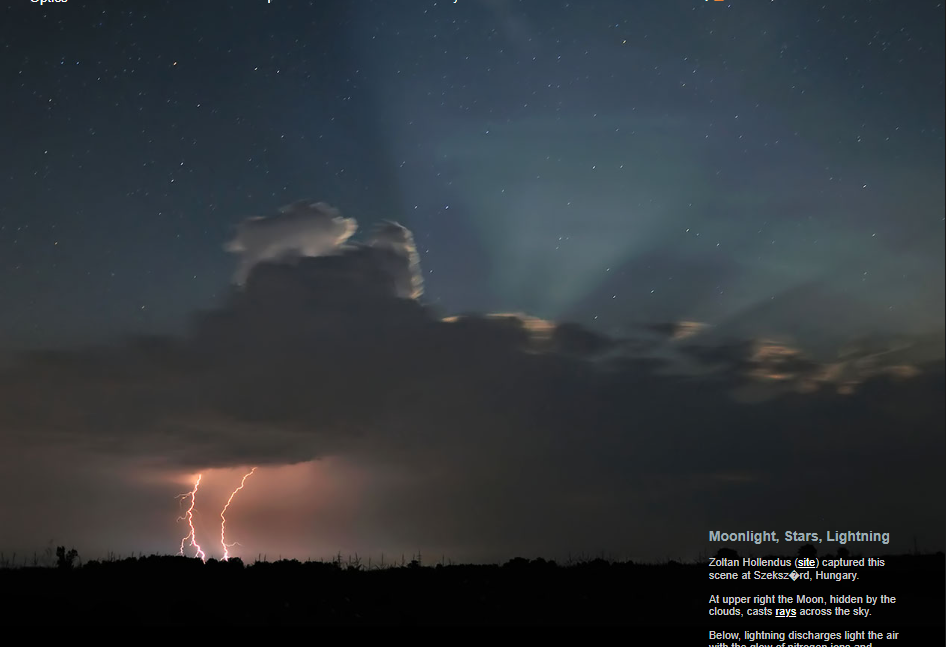OPOD - Moon, Stars, Rain & Fire
OPOD - Moon, Stars, Rain & Fire: A Captivating Display of Atmospheric Optics
Atmospheric optics never fails to mesmerize us with its enchanting displays. In this particular scene captured by Zoltan Hollendus in Szekszárd, Hungary, we are treated to a captivating combination of moonlight, stars, and lightning. Let's dive into the details of this extraordinary spectacle and explore the fascinating phenomena that create such a breathtaking view.
Moonlight Illuminating the Sky
As we gaze at the image, our attention is immediately drawn to the upper right, where the Moon shines through the veil of clouds. Despite its partial concealment, the Moon's rays manage to cast ethereal beams across the sky. These moonlit rays, often referred to as crepuscular rays or sunbeams, are caused by the scattering of light by dust or other atmospheric particles. They create a dramatic effect, adding depth and dimension to the scene.
The Radiant Power of Lightning
Beneath the Moon, a display of lightning illuminates the night sky. Lightning is a powerful natural phenomenon that occurs when there is an electrical discharge between clouds or between a cloud and the ground. It generates immense amounts of energy, which manifests as a brilliant flash of light. This light is produced by the excitation and ionization of air molecules in the lightning channel.
The Science Behind Lightning's Glow
Denis Joye's lightning spectrum provides us with a deeper understanding of the emissions associated with lightning. It reveals the presence of excited nitrogen ions and hydrogen atoms within the lightning stroke. These ions and atoms emit light at specific wavelengths, giving rise to the mesmerizing colors we observe during a lightning strike.
The Intense Heat of Lightning
Beyond its luminous display, lightning also generates extreme temperatures within its narrow channel. Temperatures during a lightning strike can reach a staggering 20,000 to 30,000 degrees Celsius (36,000 to 54,000 degrees Fahrenheit). To put this into perspective, these temperatures are 3 to 5 times hotter than the surface of the sun. Such intense heat is sufficient to dissociate air and water molecules and transform them into a glowing plasma.
The Role of Nitrogen Ions and Hydrogen Atoms
The high temperatures within a lightning channel cause the air molecules to break apart. Nitrogen molecules, which make up the majority of our atmosphere, split into individual nitrogen atoms and ions. Similarly, water molecules dissociate into hydrogen atoms and ions. These excited nitrogen ions and hydrogen atoms emit light as they return to their normal energy states, creating the colorful glow associated with lightning.
Lightning's Impact on Atmospheric Chemistry
In addition to its visual splendor, lightning plays a crucial role in atmospheric chemistry. The high energy levels of lightning facilitate chemical reactions in the atmosphere. For example, the dissociation of nitrogen molecules leads to the formation of nitric oxide (NO) and other nitrogen compounds, which are important contributors to air pollution and the ozone layer's dynamics. Lightning also contributes to the production of ozone through the interaction of oxygen molecules with energetic electrons produced during the discharge.
The Dynamic Nature of Atmospheric Optics
This captivating image serves as a reminder of the dynamic nature of atmospheric optics. The interplay between moonlight, stars, and lightning creates an ever-changing spectacle that captivates our senses. It is a testament to the complexity and beauty of the natural world around us.
Conclusion
The convergence of moonlight, stars, rain, and fire in this remarkable scene showcases the wonder of atmospheric optics. From the ethereal moonbeams casting their glow across the sky to the powerful display of lightning illuminating the darkness, each element contributes to a mesmerizing visual experience. Delving into the science behind these phenomena unveils the intricate processes occurring within our atmosphere. Atmospheric optics continues to amaze us, reminding us of the endless mysteries that await our exploration.

Moonlight, Stars, Lightning
Zoltan Hollendus (site) captured this scene at Szeksz�rd, Hungary.
At upper right the Moon, hidden by the clouds, casts rays across the sky.
Below, lightning discharges light the air with the glow of nitrogen ions and hydrogen atoms generated for a brief instant by temperatures 3-5X those of the sun's surface.
©Zoltan Hollendus, shown with permission.

A lightning spectrum obtained by Denis Joye showing emissions from excited nitrogen ions and hydrogen atoms. A lightning stroke is several km long but only a few centimetres in diameter. Within there are temperatures of 20-30,000 Celsius - Enough to dissociate air and water molecules and ionise to a plasma..
Note: this article has been automatically converted from the old site and may not appear as intended. You can find the original article here.
Reference Atmospheric Optics
If you use any of the definitions, information, or data presented on Atmospheric Optics, please copy the link or reference below to properly credit us as the reference source. Thank you!
-
<a href="https://atoptics.co.uk/blog/opod-moon-stars-rain-fire/">OPOD - Moon, Stars, Rain & Fire</a>
-
"OPOD - Moon, Stars, Rain & Fire". Atmospheric Optics. Accessed on November 26, 2024. https://atoptics.co.uk/blog/opod-moon-stars-rain-fire/.
-
"OPOD - Moon, Stars, Rain & Fire". Atmospheric Optics, https://atoptics.co.uk/blog/opod-moon-stars-rain-fire/. Accessed 26 November, 2024
-
OPOD - Moon, Stars, Rain & Fire. Atmospheric Optics. Retrieved from https://atoptics.co.uk/blog/opod-moon-stars-rain-fire/.